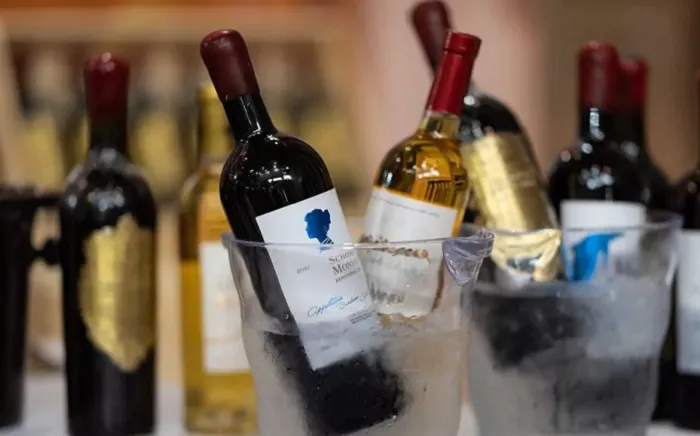LIGNORELLES, France (AP) — On a crisp September morning in Chablis, grape pickers climb the steep slopes of the Vau de Vey vineyard, hauling heavy buckets of Chardonnay grapes. It’s the final day of harvest at the Domaine Roland Lavantureux winery, but this year’s yield tells a story of struggle.
Despite the labor and effort, wine enthusiasts may find it difficult to secure a bottle of the 2024 vintage. Much of France’s renowned wine regions, including Chablis, faced one of the wettest years on record due to unpredictable climate changes. The impact of harsh weather has led to diminished yields, making this year’s Premier Cru wines both scarce and distinct in character.
A Year of Extreme Weather Hits Chablis
The 2024 growing season proved challenging for Chablis vineyards, marked by a series of weather calamities. At Domaine Roland Lavantureux, the harvest lasted just nine days—about half the usual time—due to extreme conditions including frost, hail, heavy rain, and an aggressive fungus.
“This has been my toughest year since I started in 2010,” said winemaker David Lavantureux. “Even the older winemakers agree it’s been particularly difficult, with weather so unpredictable we’ve faced one challenge after another.”
The difficulties began in April, when frost hit the region, followed by a hailstorm in May that ravaged the vineyards. Persistent rain throughout the summer only compounded the problems, creating the perfect environment for mildew, a destructive fungus, to thrive. According to Burgundy’s wine federation, approximately 1,000 hectares (about 2,500 acres) of vines in Chablis were impacted by May’s storm, worsening the mildew outbreak.
Disease Ravages Crops
The mildew disease proved devastating, causing significant crop losses and jeopardizing wine quality. David and his brother Arnaud fought to control the fungus using various treatments, but persistent rain rendered most efforts ineffective.
“We’re facing a 60 to 65% loss in yield this year,” David explained. “It’s going to be a low-production season.”
The Lavantureux estate isn’t alone. Vineyards across France, especially in regions like Burgundy, have struggled with reduced production in 2024. According to France’s agriculture ministry, total wine production is estimated at 39.3 million hectoliters, down 18% from last year and 11% below the five-year average.
Arnaud, who worked alongside his brother throughout the season, reflected on the grueling year: “It’s been physically and mentally exhausting. We’re just relieved the harvest is finally over.”
Impact on Wine Quality
This year’s challenging conditions will shape the 2024 vintage, influencing its taste and structure. Arnaud pointed out that the wine will have higher acidity and less optimal maturity due to the rapid harvest and weather setbacks. Despite these obstacles, the Lavantureux brothers remain focused on crafting a balanced wine from what remains of the crop.
“We aim for perfection in every bottle,” Arnaud said. “The balance might be different this year, but we’ll work to create something special.”
Coping with Climate Change
Chablis, nestled in northern Burgundy, traditionally enjoyed favorable growing conditions with cold winters, warm summers, and moderate rainfall. However, climate change is disrupting that pattern. Unseasonably mild winters, increased rainfall, and more frequent spring frosts are becoming the new normal.
Frost, in particular, has been a recurring nightmare for French winemakers. Recent years have seen catastrophic frosts that decimated vineyards, including a devastating cold snap in 2021 which scientists attribute to climate change.
“At one point, we thought global warming would shield Chablis from frost,” David noted. “But over the last 15 years, frost has returned with greater intensity.”
Winemakers are adopting innovative strategies to adapt. Techniques like delaying pruning to postpone budburst, using larger leaf canopies to protect grapes from excessive sun, and employing frost protection measures such as lighting candles or spraying water on vines are becoming common practices.
In Burgundy, anti-hail devices have also been installed, though they only offer partial protection. “We’ve had some success with these measures, but they’re not foolproof,” David said. “This year’s hailstorms, especially two severe ones, were a harsh reminder.”
Looking Forward with Resilience
Fortunately, the Lavantureux family can rely on two successful years in 2022 and 2023 to soften the financial blow of the 2024 harvest. Global demand for Chablis, particularly in the United States, remains robust. The Burgundy wine association recently reported that Chablis wine exports to the U.S. grew by 19% in 2023, reaching 3 million bottles and generating 368 million euros ($410 million) in revenue.
Despite the challenges of 2024, the Lavantureux family is already looking ahead. “We’ve put this year’s harvest behind us,” Arnaud said with a sense of optimism. “Now, we’re focused on the next one.”
A Challenging Year for French Winemakers
This year’s difficulties underscore the growing impact of climate change on winemaking. French vineyards, long known for producing some of the finest wines in the world, are increasingly vulnerable to extreme weather events. Whether it’s frost, hail, or mildew, winemakers must continue to adapt to protect their crops and the quality of their wines.
For the Lavantureux family and others across Chablis, resilience, innovation, and a deep connection to the land will be key to overcoming future challenges. As climate unpredictability continues to reshape the wine industry, vintners will need to evolve their practices to preserve the time-honored tradition of French winemaking.
You Might Be Interested In:


